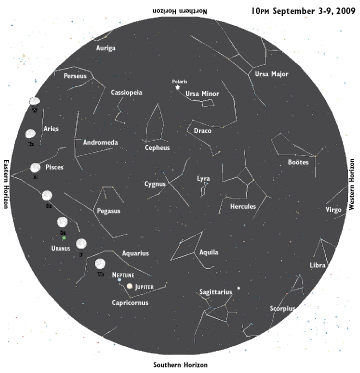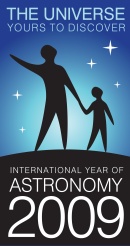
Volume XVII, Issue 36 # September 3 - September 9, 2009 |
 |
 |
 Sky Watch
Sky Watch
by J. Alex Knoll
Nearing the Tipping Point
There’s a fine balance between sun and moon
The full moon rises Friday a little south of due east as the sun sets just north of due west. Through the evening and the wee hours leading to dawn, the moon arcs lazily through southern skies until setting just south of due west as the sun rises just north of due east.
 This is no coincidence. As the moon emits no light of its own, what we see is sunlight reflected from the lunar surface and back to us here on Earth. Only when the earth is directly between the sun and moon is the moon’s full face lit up. After Friday, as that alignment deteriorates, the angle of reflection changes, shrinking the illuminated portion of the moon. By last-quarter, the moon, sun and Earth form a 90-degree angle. As the moon moves between the earth and sun, we see less and less of the moon aglow, until it disappears when directly between Earth and sun.
This is no coincidence. As the moon emits no light of its own, what we see is sunlight reflected from the lunar surface and back to us here on Earth. Only when the earth is directly between the sun and moon is the moon’s full face lit up. After Friday, as that alignment deteriorates, the angle of reflection changes, shrinking the illuminated portion of the moon. By last-quarter, the moon, sun and Earth form a 90-degree angle. As the moon moves between the earth and sun, we see less and less of the moon aglow, until it disappears when directly between Earth and sun.
Traditionally, September’s full moon is the Harvest Moon. Not so this year, as that distinction is reserved for the full moon closest to autumnal equinox on September 22. With the moon’s 281⁄2 -day cycle, every few years there are 13 full moons, and this is one of those years. So Friday’s full moon is known as the Red Moon because of the ruddy hue it takes on in late-summer’s sultry haze.
While this month’s waning moon rises and sets nearly 25 minutes later each day, the sun’s movements are more subtle. As you look to the horizon at sunset or sunrise, note the point at which it crosses the horizon. As we near autumnal equinox over the next couple weeks, the rising sun will inch its way closer and closer to the due-east mark, while the setting sun edges toward cardinal west. Then, on September 22, it will rise at due east and set at due west.
Illustration: © Copyright 1925 M.C. Escher/Cordon Art-Baarn-Holland; Graphics: © Copyright 2009 Pacific Publishers. Reprinted by permission from the Tidelog graphic almanac. Bound copies of the annual Tidelog for Chesapeake Bay are $14.95 ppd. from Pacific Publishers, Box 480, Bolinas, CA 94924. Phone 415-868-2909. Weather affects tides. This information is believed to be reliable but no guarantee of accuracy is made by Bay Weekly or Pacific Publishers. The actual layout of Tidelog differs from that used in Bay Weekly. Tidelog graphics are repositioned to reflect Bay Weekly’s distribution cycle.Tides are based on National Oceanic and Atmospheric Administration and are positioned to coincide with high and low tides of Tidelog.
